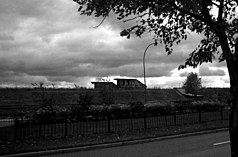Victoriatown
| Goose Village | |
|---|---|
| Abandoned town | |
| Victoriatown | |

Old Victoriatown train station, as it appeared in 2007.
|
|
| Location of Goose Village in Montreal | |
| Coordinates: 45°28′57″N 73°32′53″W / 45.48240°N 73.54802°WCoordinates: 45°28′57″N 73°32′53″W / 45.48240°N 73.54802°W | |
| Country | Canada |
| Province | Quebec |
| City | Montreal |
| Borough | Le Sud-Ouest |
| Area | |
| • Land | 0.47 km2 (0.18 sq mi) |
| Elevation | 20 m (70 ft) |
| Population (2011) | |
| • Total | 0 |
| • Density | 0/km2 (0/sq mi) |
| • Population (1963) | 1,500 |
Goose Village (French: "Village-aux-Oies") was a neighbourhood in Montreal, Quebec, Canada. Its official but less commonly used name was Victoriatown, after the adjacent Victoria Bridge. The neighbourhood was built on an area formerly known as Windmill Point, where thousands of Irish immigrants died from disease in 1847 and 1848.
Goose Village was located near Griffintown, in what is now the southwest borough. The community encompassed six streets, in what is now a bus station and parking lot. The streets were named after various bridges designed by the principal engineer of the Victoria Bridge, Robert Stephenson.
Windmill Point was a quarantine area where between 3,500 and 6,000 Irish immigrants died of typhus or "ship fever" in 1847 and 1848. The immigrants had been transferred from quarantine in Grosse Isle, Quebec. Due to a lack of suitable preparations, typhus soon reached epidemic proportions in Montreal. Three fever sheds were initially constructed, 150 feet (46 m) long by 40 to 50 feet (15 m) wide. As thousands more sick immigrants landed, more sheds had to be erected.
The number of sheds would grow to 22, with troops cordoning off the area so the sick couldn't escape. Grey Nuns cared for the sick, carrying women and children in their arms from ships to the ambulances. According to Montreal journalist and historian Edgar Andrew Collard, thirty of 40 nuns who went to help became ill, with seven dying. Other nuns took over, but once the surviving Grey Nuns had convalesced, they returned. Priests also helped, many falling ill after hearing the last confessions of the dying. When a mob threatened to throw the fever sheds into the river, Montreal mayor John Easton Mills quelled the riot and provided care, giving patients water and changing bedding. He died in November, having served less than a year in office. The Roman Catholic Bishop of Montreal urged French Quebecers to help their fellow Catholics. Many travelled to Montreal from the countryside to adopt children, in some cases passing their land on to them.
...
Wikipedia

